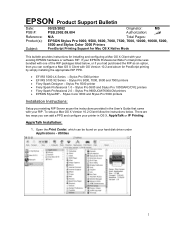
- FREE RIP SOFTWARE FOR EPSON 7600 PRINTERS FOR FREE
- FREE RIP SOFTWARE FOR EPSON 7600 PRINTERS DRIVER
- FREE RIP SOFTWARE FOR EPSON 7600 PRINTERS PRO
What this means is that if you have a 7600 0r 9600, you may not need to buy another printer to get outstanding B&W prints.

You get gallery quality prints, with no crossover effects and *no* metamerism, and excellent shadow detail. I have been experimenting with the grey profiles and tint picker, and the results look sensational (even with the wrong profile for my preferred paper - Colorbyte are fixing that right now). In addition to this, ImagePrint has a "Tint Picker" to allow subtle toning to allow you to print a cool or warm print. This uses proprietory profiling software to produce grey profiles specifically to print B&W through the 76 printers. My 7600 is run by the ImagePrint 5 RIP from Colorbyte.
FREE RIP SOFTWARE FOR EPSON 7600 PRINTERS PRO
Used this way, it is in my view no match for a properly working 7000 with Piezo Pro where B&W is concerned.īut.add in ImagePrint 5 to the mix, and you have a whole new ball game.
FREE RIP SOFTWARE FOR EPSON 7600 PRINTERS DRIVER
For B&W work, a print made using the Epson driver can look a little greenish and have blocked shadows. I agree with the comments generally made about this printer. Further, there is some uncertaintly over the future of the current Piezo Pro software. The 7000 is capable of superb B&W results, but there are some issues with the current ink/software combination that you need to consider (I have had some banding since changing to the latest Piezotone inks, for example). Under a loup, you might sometimes see a fine check pattern that reflects the unique method of laying down ink. The 7000, driven by Piezography Pro software and using the original "sundance" inks produces excellent, continuous tone B&W prints. I can answer your question - or at least give you my subjective impressions, as I own both a 7600 and a 7000 driven by the Cone Piezo Pro system. This doesn't happen at all on watercolor papers- prints made on those papers look just like quadtone prints. In oblique reflected light, you can see what looks like an oily yellow sheen on the print. The 7600 lays down the yellow ink last, and so it sits on the surface of glossy prints. The only problem i've seen with the 7600 is that when printing on glossy papers, there is a yellowish reflective sheen on the print that is quite unattractive when viewed in the wrong light. Like the quadtone system, the 7600 can produce prints that have NO visible dot pattern, even in the places you'd expect dots such as white clouds. In terms of direct comparisons, i haven't done a side-by-side, but i have seen incredibly beautiful B&W prints from both processes.
FREE RIP SOFTWARE FOR EPSON 7600 PRINTERS FOR FREE
With a good profile (such as those that are just about to be made available for free on Epson's site), the gray balance is perfect through the entire tonal scale. And of course, split toning and other effects are easy to achieve. The process uses all the inks, so the print can be toned in whatever color you want, however subtle. The B&W printing that can be done on the 7600 is also pretty amazing.

For larger prints I doubt the difference would be noticable between the 7600 and a previous Epson such as the 7000, because then the limitation is the sharpness of the file, not the sharpness of the printer. For small prints it is really amazing- it will print a line the width of a human hair. Here are my thoughts.įirst, the 7600 is fantastically sharp- noticeably sharper than any previous inkjet printer (including all the Epsons). Nathan, I own one of the new Epson 7600 printers and have made approximately 300 linear feet of prints with it so far.

Also, go to the 'What's New' section to see all the articles on the 2200, as there has been great consternation toward Epson USA over the lack of inclusion of a program called the 'Gray Balancer' which provides powerful control over the appearence of black and white prints. I believe the new larger printers are built around the same printer head and inks, so results should be similar.Īnd there is a link to other articles at the bottom. The author of the initial review (Michael Reichmann) indicated that he has done away with his piezography printer in favor of the new inks in the 2200. Thhere are several reviews on the site, dealing with various aspects of the printer, including black and white printing. However, there is a review of the new 2200 printer at that discusses this issue. I can't directly answer your question, as I have no experience with the Cone products.


 0 kommentar(er)
0 kommentar(er)
